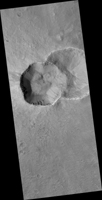
Map Projected Browse Image
Click on image for larger versionThis image covers two overlapping impact craters, one approximately 4 kilometers in diameter and a second that is about 3 kilometers wide. The smaller crater has a sharply defined rim that interrupts the rim of the larger one, indicating that the smaller crater formed more recently.
Rocks of several different colors are exposed in this crater's walls; they are undergoing erosion into finer-grained debris that travels downwards and accumulates in small fans on the crater floor. The rocks exposed on the eastern crater wall appear bluer in enhanced color than the redder rocks of the southern wall.
These craters are in the Terra Cimmeria region of Mars' Southern Highlands, where they provide windows into the diverse compositions of the ancient bedrock.
The map is projected here at a scale of 25 centimeters (9.8 inches) per pixel. (The original image scale is 25.9 centimeters [10.2 inches] per pixel [with 1 x 1 binning]; objects on the order of 78 centimeters [30.7 inches] across are resolved.) North is up.
The University of Arizona, in Tucson, operates HiRISE, which was built by Ball Aerospace & Technologies Corp., in Boulder, Colorado. NASA's Jet Propulsion Laboratory, a division of Caltech in Pasadena, California, manages the Mars Reconnaissance Orbiter Project for NASA's Science Mission Directorate, Washington.

